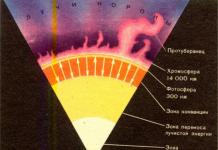Slide 2
5.1. Measuring direct solar radiation. Pyrheliometer and actinometer. 5.2. Measurement of scattered radiation. Pyranometer. 5.3. Measurement of radiation balance. Balance meter.
Slide 3
5.1.Measurement of direct solar radiation. Pyrheliometer and actinometer.
Actinometric measurements are measurements of various radiation fluxes in the atmosphere. The main actinometric quantities are the following. 1.Direct solar radiation. Present only during the day with clear skies. 2. Scattered solar radiation. Present during daylight hours. 3. Radiation balance. This is the algebraic sum of all flows from the upper hemisphere minus the sum of all flows from the lower hemisphere.
Slide 4
5.1.Measurement of direct solar radiation. Pyrheliometer and actinometer. To measure direct solar radiation, one of two instruments is used: a compensation pyrheliometer or a thermoelectric actinometer. The compensation pyrheliometer is an absolute device, the thermoelectric actinometer is a relative one. Absolute instruments are based on comparison of the measured parameter with another similar parameter, the value of which can be adjusted during the measurement process. Example - cup scales. Absolute instruments do not require calibration and do not have a scale. Relative instruments are based on converting the measured quantity into another physical quantity, the value of which is quite simple to measure. An example is a spring scale with an arrow. Relative instruments are calibrated by comparison with absolute ones.
Slide 5
5.1.Measurement of direct solar radiation. Pyrheliometer and actinometer. Rice. 5.1.1. External view of the Angstrom compensation pyrheliometer.
Slide 6
5.1.Measurement of direct solar radiation. Pyrheliometer and actinometer. 4 K ma G R 1 2 3 3’ Fig. 5.1.2. Scheme of a compensation pyrheliometer. 1 – cover; 2 – holes in the cover; 3, 3’ – black plates; 4– thermocouple; G – galvanometer; ma – milliammeter. The pyrheliometer is pointed at the Sun. One of the holes is closed. The sun illuminates only one of the plates. It's heating up. The second plate is heated by electric current from the battery. The current is regulated by resistor R. The temperature difference between the plates is monitored by a thermocouple (4) with a galvanometer G. The observer achieves a zero reading on the galvanometer, and then measures the current i heating the plate using a milliammeter ma.
Slide 7
5.1.Measurement of direct solar radiation. Pyrheliometer and actinometer. Heat flow to platinum heated by solar radiation: (5.1.1) S – direct solar radiation; – coefficient of absorption of solar radiation by the plate; s is the area of the plate. Heat flow onto platinum heated by electric current i: R is the resistance of the plate. (5.1.2) If the temperatures of the plates are equal, both flows are equal:
Slide 8
5.1.Measurement of direct solar radiation. Pyrheliometer and actinometer. Then we get: where k is the conversion factor for this device. (5.1.3) The pyrheliometer is inconvenient for field measurements. Measurements take a long time. It is only used for factory calibration of the actinometer.
Slide 9
5.1.Measurement of direct solar radiation. Pyrheliometer and actinometer. Thermoelectric actinometer. Rice. 5.1.3. Appearance of a thermoelectric actinometer.
Slide 10
5.1.Measurement of direct solar radiation. Pyrheliometer and actinometer. Rice. 5.1.4. Thermoelectric actinometer M-3 (AT-50). 1 - blackened disk, 2 - copper ring, 3 - thermopile, 4 - successively narrowing diaphragms, 5 - metal cylinder (body), 6 - hole in the disk for pointing the actinometer at the sun. to galvanometer 6 5 black disk (1) 4 copper ring (2) Thermopile (3)
Slide 11
5.1.Measurement of direct solar radiation. Pyrheliometer and actinometer. The black disk is heated by solar radiation. The copper ring has air temperature. The temperature difference between the disk and the ring is proportional to the amount of direct solar radiation. This difference is measured using a thermopile and a galvanometer. Direct solar radiation is calculated using the formula: (5.1.4) where k is the conversion factor determined at the factory; N – galvanometer readings in divisions; N0 is the zero point of the galvanometer (usually 3-5 divisions).
View all slides
1. The concept of “solar radiation”. Solar radiation intensity, solar constant.
2. Solar radiation at the upper boundary of the atmosphere.
3. Solar radiation in the atmosphere (direct, diffuse, total).
4. Solar radiation at the earth's surface (albedo, counter, terrestrial and effective radiation).
5. Radiation regime of the atmosphere and surface of the Earth.
6. Heat balance.
1. The concept of “solar radiation”. Solar radiation intensity, solar constant.
The earth rotates in the flow of the sun's rays. And although only one two-billionth part of all solar radiation reaches it, this amounts to 1.36 x 1024 cal per year. For comparison: the radiant energy of stars is one hundred millionth of the incoming solar energy, cosmic radiation is two billionths, the internal heat of the Earth at its surface is equal to one thousandth of solar heat.
Thus, the electromagnetic radiation of the Sun - solar radiation - is the main source of energy for processes occurring in the geographic envelope. This radiation consists of visible (46%) and invisible (54%).
The unit of measurement of solar radiation intensity is the number of calories of heat absorbed by 1 cm2 of an absolutely black surface perpendicular to the direction of the sun's rays in 1 minute (cal/cm2 x min).

The flow of radiant energy from the Sun approaching
the earth's atmosphere, is characterized by great constancy. Its intensity is called the solar constant (I0) and is taken equal to 1.98 cal/cm2 x min.
Depending on changes in the distance from the Earth to the Sun during the year, the solar constant fluctuates: by the beginning of January it increases, by the beginning of July it decreases. The annual fluctuations in the solar constant are about 3.5%. For every 1 cm2 of the earth's surface there are about 260 kcal per year. The amount of solar radiation entering an area of the earth's surface depends on the angle of incidence of the sun's rays. The smaller the angle of incidence of the rays, the lower the intensity of solar radiation.
The amount of solar radiation received by a surface is directly dependent on the duration of its illumination by the sun's rays.


2. Solar radiation at the upper boundary
atmosphere.
In the equatorial belt (outside the atmosphere), the amount of solar heat does not experience large fluctuations throughout the year, but in high latitudes these fluctuations are large. In winter, the influx of solar heat between high and low latitudes is especially significant. In summer, under conditions of continuous illumination, the polar regions receive the maximum amount of solar heat per day on Earth. This amount on the day of the summer solstice in the northern hemisphere is 36% higher than the daily amount of heat at the equator. But since the length of the day at the equator is not 24 hours, as at this time at the pole, but 12 hours, the amount of solar radiation per unit time at the equator remains the greatest. The summer maximum of the daily amount of solar heat, observed at about 40–500 latitudes, is due to the fact that here, at a significant height of the Sun, there is a relatively long day length (longer than at the equator). The differences in the amount of heat received by the equatorial and polar regions are smaller in summer than in winter.
Slide presentation
Slide text: * Lecture 3. Natural and climatic conditions of the environment and human health. Acclimatization and its hygienic significance. Solar radiation. Agafonov Vladimir Nikolaevich

Slide text: * Climate is the average long-term weather pattern, which is one of the main characteristics of a given area. Climate features are determined by: - the influx of solar radiation; - processes of air mass circulation; - the nature of the underlying surface (asphalt, forest, fields).

Slide text: * Weather - the state of the atmosphere in the place in question at a certain moment or for a limited period of time (day, month). Characterized by meteorological elements and their changes: temperature, atmospheric pressure, air humidity, wind, cloudiness, precipitation, visibility range, fog, soil condition, snow depth, precipitation, etc.

Slide text: The most important climate-forming factors: geographic latitude, which determines the influx of solar energy; relief and type of earth's surface (water, land, vegetation); height above sea level; features of air flow circulation; proximity to seas and oceans. *

Slide text: Main climatic zones: Depending on the main climatological indicators, there are seven main climatic zones on the globe: tropical (0-13° latitude); hot (13 - 26°); warm (26 - 39°); moderate (39 - 52°); cold (52 - 65°); severe (65 - 78°); polar (69 - 90°). *

Slide text: * The climate is divided into 4 climatic regions: cold - / T- (-28-14) - (+4-20)/; moderate –/ T- (-14-4) -(+10-22)/; warm - / T- (-4- 0) - (+22-28)/; hot / T- (-4+4) -(+28-34)/.

Slide text: Types of climate zones: Gentle is a warm climate, characterized by small amplitudes of atmospheric air temperature fluctuations and small fluctuations in daily, monthly and annual values of other meteorological factors. Such a climate places minimal demands on adaptive mechanisms. The irritating climate has significant daily and seasonal fluctuations in meteorological indicators. Such a climate causes increased tension in the adaptation mechanisms in the human body. The cold climate of the North, the high mountain climate and the hot climate of the steppes and deserts are irritating. *

Slide text: * The adaptive type is the norm of a biological reaction to the environment, ensuring the best adaptability to the environment and its ecology. There are 4 adaptive ecological types: temperate, arctic, tropical and mountain. Adaptive types differ not only in appearance, but also in physiological processes in the body, the nature of metabolism, a set of characteristic enzyme systems and specific diseases, etc.

Slide text: * Acclimatization is the adaptation of the human body to new climatic conditions. Acclimatization is achieved by developing in people a dynamic stereotype corresponding to given climatic conditions. The physiological mechanisms of acclimatization are diverse and depend on specific climatic characteristics.
Slide No. 10

Slide text: Phases of acclimatization: There are three phases of acclimatization: the initial phase, during which physiological adaptive reactions occur in the body, described above using the example of high-mountain, cold and hot climates; the phase of restructuring a dynamic stereotype, which can develop favorably or unfavorably. If the course of the second phase is unfavorable, a person experiences pronounced disadaptation processes in the form of: meteoneurosis, decreased performance, exacerbation of chronic diseases, development of myalgia, neuralgia and other pathological conditions. In such people, the third phase - stable acclimatization does not occur, and the person needs to return to previous climatic conditions; the phase of stable acclimatization is characterized by the usual level and nature of morbidity, stability of metabolic processes, normal fertility and good physical development of newborn children. *
Slide No. 11

Slide text: * Anticyclones are areas of high pressure with a diameter of 5 - 7 thousand km, with an increase in atmospheric pressure from the periphery to the center.
Slide No. 12

Slide text: * Cyclones are areas of low pressure with a diameter of 2 - 3 thousand km, with a drop in atmospheric pressure from the periphery to the center.
Slide No. 13

Slide text: Planck's formula e = hf, where e is the quantum energy, f is the oscillation frequency, h is the quantum constant. *
Slide No. 14

Slide text: BORDERS OF THE SOLAR SPECTRUM 1) Infrared rays (IR) - from 0.76 to 60 microns; 2) Visible rays - 400-760 nm; 3) Ultraviolet rays (UV) - 10-400 nm. *
Slide No. 15

Slide text: Division of the ultraviolet spectrum The ultraviolet spectrum is divided into 3 regions: A - 400-320 nm (predominant erythemal and tanning effect); B - 320-280 nm (predominant antirachitic or vitamin-forming effect); C - 280-200 nm (predominant bactericidal effect) *
Slide No. 16

Slide text: Effect of ultraviolet rays 1. Strengthening metabolism and enzymatic processes. 2. Increased tone of the central nervous system and a stimulating effect on the sympathetic nervous system with subsequent regulation of cholesterol metabolism. 3. An increase in the immunobiological reactivity of the body is associated with an increase in the globulin fraction of the blood and the phagocytic activity of leukocytes. There is also an increase in the number of red blood cells and hemoglobin content. 4. Changes in the activity of the endocrine system: - stimulating effect on the sympatho-adrenal system (increase in adrenaline-like substances and blood sugar); - inhibition of pancreatic function. 5. Specific formation of vitamin D3. 6. An increase in the body’s resistance to the action of ionizing radiation is noted. 7. Bactericidal - destructive effect on microorganisms. *
Slide No. 17

Slide text: A set of hygienic measures 1. The fight for a clean atmosphere; 2. The use of architectural and planning techniques that ensure the penetration of UV rays into the building (northern regions of the country); 3. Use in construction of uviol glass, cellulose acetate film, cellophane (reinforced nylon), transmitting UV rays; 4. Extensive implementation of sanitary and educational work; 5. The use of solariums, consisting of booths covered with polyethylene film, in order to prolong sunbathing and protect from strong winds. *
Slide No. 18

Slide text: * THANK YOU FOR YOUR ATTENTION!

Types of radiation: Direct radiation. On a clear, cloudless day, solar heat and light come to the earth's surface in the form of direct radiation. Scattered radiation. On a cloudy day, the sun is not visible in the sky, but the entire vault of heaven glows softly, this is scattered radiation. Total radiation. Radiation that reaches the earth's surface in the form of the sum of direct and diffuse radiation is called total radiation. Absorbed radiation. The part of solar energy that goes to heat the earth's surface is called absorbed radiation. Reflected radiation

The amount of solar radiation in different regions of the country: Polar region (Norilsk) - less than 80 cm 2 per year of solar radiation; Arctic region (Norilsk) – less than 80 cm 2 per year of solar radiation; Central Russia (Moscow region) - from 80 to 100 cm 2 per year of solar radiation; Central Russia (Moscow region) - from 80 to 100 cm 2 per year of solar radiation; Kemerovo region - 100 cm 2 per year of solar radiation; Kemerovo region - 100 cm 2 per year of solar radiation; South (Astrakhan) - more than 100 cm 2 per year of solar radiation. South (Astrakhan) - more than 100 cm 2 per year of solar radiation.

Distribution of solar radiation on the territory of Russia: The largest amount of solar radiation on the territory of Russia was recorded between 40 0 N latitude. (more than 100 cm 2 per year); The largest amount of solar radiation in Russia was recorded between 40 0 N latitude. (more than 100 cm 2 per year); Average amount of solar radiation (from 80 to 100 cm 2 per year): Average amount of solar radiation (from 80 to 100 cm 2 per year): in the west N.N. in the east 54 0 N.N. Lowest amount of solar radiation: 62 0 N latitude (less than 80 cm 2 per year) Lowest amount of solar radiation: 62 0 N latitude (less than 80 cm 2 per year)


In the city of Norilsk there is a minimum of solar radiation, because the point is the farthest from the equator. Therefore, people receive very little vitamin D. In Moscow, the level of solar radiation is approximately normal. In the Kemerovo region, solar radiation is normal and approximately constant. But people living in Astrakhan actively produce melanin, a high metabolic rate in the body. This city is closest to the equator.





















